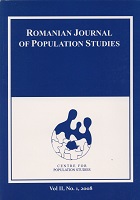Two-Children-Family Model in the Evangelical Community in Transylvania. Case Study
Two-Children-Family Model in the Evangelical Community in Transylvania. Case Study
Author(s): Bogdan Iancu CrăciunSubject(s): History
Published by: Centrul de Studiere a Populaţiei
Keywords: demography; Transylvania; Saxon family; fertility
Summary/Abstract: In Transylvania, the period between the 1848 Revolution and World War I was one of transition and of profound political, economic and social change. As for the Transylvanian Saxons, an autonomous nation since colonization times, they became an ethnic minority. The Saxon nation also changed demographically: the urban population increased at a faster pace (61.75%) than the rural one (8.46%), with transatlantic migration as one way of taking part in the modernization process. Throughout six decades, the Saxon population increased by 18 percent, from 174,606 individuals in 1850 to over 205,000 at the end of this period. However, this increase in absolute numbers hides considerable differences in demographic dynamics between the various regions. This paper deals primarily with the population of the Northern Group (the Bistriţa-Reghin area), whose evolution does not follow the general pattern of the Transylvanian Saxons. The concerning decrease of population in these communities reflects the tendency towards a voluntary limitation of the number of children born in a family.
Journal: Romanian Journal of Population Studies
- Issue Year: 2/2008
- Issue No: 1
- Page Range: 19-32
- Page Count: 14
- Language: English
- Content File-PDF

